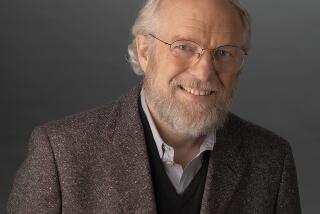Column: A new boss ponders the past and future of the fabled Xerox PARC
Few executives have moved into new jobs as freighted with history as Tolga Kurtoglu. When he became chief executive of Xerox PARC on Jan. 10, he inherited the legacy of one of Silicon Valley’s most revered institutions.
The Xerox Palo Alto Research Center is the birthplace of personal computing, the graphical user interface, the Ethernet, the laser printer, and key elements of what became the Internet. Members of its founding generation of engineers and computer scientists went on to create their own companies, such as Adobe and 3Com, and create new products and inspire innovation at fledgling companies such as Apple and Microsoft.
Pride in that record still infuses PARC. “The creative aspects of thinking about hard problems and finding solutions to them is still there,” the Ankara, Turkey-born Kurtoglu, 40, told me during a recent interview from his Palo Alto office. “But there’s more of a pragmatic view of the world in today’s PARC compared to the past.”
We don’t advance the science for the sake of advancing the science ... but we ask hard questions about whether the market needs it.
— PARC CEO Tolga Kurtoglu
Instilling a “pragmatic view” in PARC has been a mission at Xerox ever since the lab’s first generation delivered those wonderful inventions along with some hard lessons for the parent.
Xerox was ill-equipped to exploit most of PARC’s inventions. It was a hulking big company that had developed as a marketing machine for big, centralized office copiers that couldn’t be purchased, only leased — with rental payments, and sales commissions, based on the number of copies produced. The company’s thousands of salesmen couldn’t figure out how they’d collect commissions on machines that didn’t require paper. Consequently, many of PARC’s innovations — the laser printer was a key exception — ended up enriching other companies.
Kurtoglu, who joined PARC in 2010 after working at Dell and NASA’s Ames Research Center, alludes to that past even as he looks ahead to PARC’s future. He says that among its core interests are artificial intelligence, machine learning, and “integrating devices, systems, and computing.” One can hear excitement rising in his voice as he describes how sensors and high-level computing can create “a whole set of new capabilities” for technologies including self-driving cars, robotics, and virtual and augmented reality. “PARC is going to be right there,” he says.
Practical applications? They range from the mundane, such as containers for milk and other perishables that judge the freshness of their contents based on the environments they’ve traversed from factory to fridge, to life-saving — expiration-tracking for vaccine and medicine supplies and sensors for soldiers’ helmets that measure their exposure to explosive impacts.
Today the lab, which employs about 260 physicists, computer and social scientists, engineers and other staff, is one of four Xerox R&D centers budgeted at a total of more than a half-billion dollars a year. That’s a far cry from the core group of perhaps 40 researchers who were at the hub of its most important inventions in the early 1970s. The lab still occupies the modernistic concrete-and-glass hillside complex opened in 1975 to accommodate a growing workforce.
The most important change at PARC has been in its business model — or to be more precise, the creation of a business model where one did not originally exist.
Xerox today is nothing like the high-flying company that founded PARC in 1970 — the year before a local journalist first used the term “Silicon Valley” in print. Back then, as I described the arrangement in my 1999 book “Dealers of Lightning,” PARC was free to look ahead to digital technologies that might erode copier demand. The catchphrase was to invent “the office of the future” — but the company was willing to indulge the view of PARC’s first director, George Pake, that it shouldn’t expect anything concrete from the lab for at least five years. The corporation’s wealth flowed west just at the moment when new technological vistas were about to open up. Many of Xerox’s new employees cherished the opportunity to make the first tracks in a field of new-fallen snow.
More recently, Xerox has struggled with technological change. Its sales declined 20% and profit fell more than 50% from 2011 through 2015. On Jan. 3, the company spun off its business services unit — the remnant of a company it acquired in 2010 — as a separate publicly traded company, Conduent. PARC will remain a wholly-owned subsidiary of the surviving Xerox, which retains its copier and printer business.
PARC today reflects a rethinking of corporate research and development that took hold in industry following its own initial sunburst. The notion that corporate researchers should follow their instincts regardless of their parents’ needs and desires is now regarded almost as quaint, though in reality it was more a myth than reality. Even AT&T’s Bell Labs, whose Nobel Prizes made it resemble an academic lab and made it a model for PARC, was largely focused on its parent’s technical demands.
Technology companies struggled to find ways to bring corporate research more in sync with business imperatives without stamping out the creative impulses that could lead to unexpected new markets. Xerox tried “intrepreneuring” by giving researchers the chance to spin off their best ideas into their own businesses or Xerox subsidiaries.
Today the watchword is “open innovation.” PARC depends on Xerox for half its revenue, with the other half raised by hiring out as an innovation farm for government and industry, helping to develop manufacturing processes and performing technical studies for clients that have included the Pentagon, Boeing, Honda and Sony. This portfolio may not have the romantic sheen of the launch of the digital age by a clutch of youthful visionaries, but Kurtoglu says it allows its staff to work within a broad business “ecosystem” while also sharing the risks inherent in early-stage R&D before a product can be commercialized.
The goal is to “bring business thinking into the mix of science and technology development,” he says. “We don’t advance the science for the sake of advancing the science per se, but we ask hard questions about whether the market needs it and who needs it and in what format.”
This mode of operation has won praise from the Harvard Business Review, which found in 2011 that “partnering closely with customers, inventing a minimally viable product, and collaboratively iterating from there based on market feedback” preserves the “enduring PARC culture of excitement about and support for invention” and made for “a winning combination.”
Whether this fosters the sort of innovation that PARC’s original scientists and engineers strived for is an open question. The original structure of PARC was a sort of “artists’ colony” whose members had a “shared feeling” about their ultimate goal, as Alan Kay, one of the original PARC computer scientists, told Fast Company in 2015. Kay, whose concept of a “personal, portable information manipulator” helped give birth to the PARC’s pioneering Alto PC, argued that a company should have an “invention center” precisely because “it’s a wild card.” But PARC-like things have failed over the years, he observed, either because they’re “so antithetical to the corporate culture that nobody really wants it,” or the impulse is to try to “monetize everything.”
SIGN UP for the free California Inc. business newsletter »
There were few limits on the participants’ imagination, but their innovations could become orphans if the parent was unable or unwilling to commercialize them.
PARC today may harbor a converse set of risks and benefits. A project may not get very far if its commercial potential remains murky; but the flashes of inspiration that can create entirely new markets may not come either.
That defines the changes in PARC’s role. Industry needs the “collaborative iteration” of nascent technologies mentioned by the Harvard Business Review. But it also needs wild cards, and they’re hard to find.
Keep up to date with Michael Hiltzik. Follow @hiltzikm on Twitter, see his Facebook page, or email [email protected].
Return to Michael Hiltzik’s blog.
MORE FROM MICHAEL HILTZIK
Paul Ryan continues his assault on Obamacare and Medicare — this time on the ‘Charlie Rose’ show
Cisco loses a round on forcing an employee into arbitration
As a space exploration target, why does Venus get no love?






